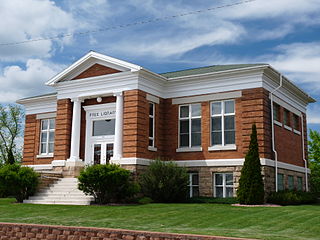| Thornapple River | |
|---|---|
| Country | United States |
| Physical characteristics | |
| Main source | NE Sawyer County, Wisconsin in Chequamegon National Forest |
| River mouth | Chippewa River near Bruce, Wisconsin 1,060 ft (320 m) [1] |
| Basin features | |
| River system | Mississippi River |
Thornapple River is a river in Sawyer and Rusk counties in the U.S. state of Wisconsin.

Sawyer County is a county in the U.S. state of Wisconsin. As of the 2010 census, the population was 16,557. Its county seat is Hayward.

Rusk County is a county in the U.S. state of Wisconsin. As of the 2010 census, the population was 14,755. Its county seat is Ladysmith.
The Thornapple rises in northeast Sawyer County in the Chequamegon National Forest at 45°56′21″N90°45′29″W / 45.93917°N 90.75806°W . [1] It flows primarily south-southwest into the Chippewa River near Bruce at 45°27′40″N91°15′09″W / 45.46111°N 91.25250°W . [1]

The Chippewa River in Wisconsin flows approximately 183 miles (294 km) through west-central and northwestern Wisconsin. It was once navigable for approximately 50 miles (80 km) of its length, from the Mississippi River, by Durand, northeast to Eau Claire. Its catchment defines a portion of the northern boundary of the Driftless Area. The river is easily accessible for bikers and pleasure seekers via the Chippewa River State Trail which follows the river from Eau Claire to Durand.

Bruce is a village in Rusk County, Wisconsin, United States. The population was 779 at the 2010 census. The village was founded in 1884 by the Sault Ste. Marie Land and Improvement Company. The land company was incorporated and led by the principal officers of the Minneapolis, Sault Ste. Marie and Atlantic Railway, which operated its ceremonial first train over its line to Bruce in November 1884. It was named for Alanson C. Bruce who operated a logging camp in the area.
Among the tributaries of the Thornapple, there are two streams named Little Thornapple River. One is a right-side tributary entirely within Sawyer County near the boundary with Rusk County, flowing from 45°40′17″N90°52′31″W / 45.67139°N 90.87528°W primarily to the west and slightly south into the Thornapple River at 45°39′09″N90°58′52″W / 45.65250°N 90.98111°W . [2] The other Little Thornapple River is a left-side tributary that rises in southern Sawyer County at 45°38′30″N91°01′39″W / 45.64167°N 91.02750°W , less than 2 miles (3.2 km) west-southwest of the mouth of the other Little Thornapple River. The second Little Thornapple, flows primarily to the south and southwest into Rusk County and empties into the Thornapple River at 45°30′04″N91°10′56″W / 45.50111°N 91.18222°W , approximately 4 miles (6.4 km) from the mouth of the Thornapple near Bruce. [3]







